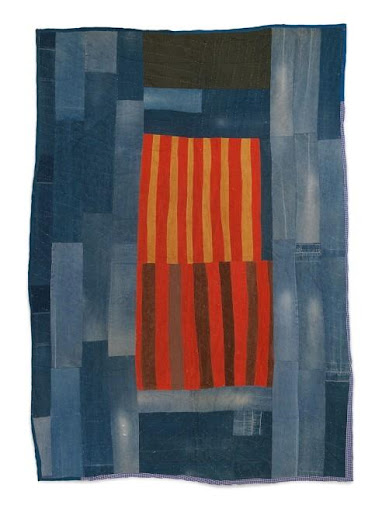By Carol Hobbs, Feb. 2023
Never has a group of women deserved fame more than the Gee’s Bend Quilters. Gee’s Bend is a small rural community of African Americans in Wilcox County, West Alabama, and is surrounded on three sides by the Alabama River. Their quilt artistry began with ancestors who were enslaved on the Gee and Pettway Plantation as way to stay warm in unheated cabins. After the Civil War, the community largely stayed on, rather than migrate to the North and Midwest, and were not afforded the opportunity to participate in the burgeoning American middle class. During extreme times in the 1930s, the Federal Government provided loans that allowed the residents to acquire land formerly worked by their ancestors. The land became theirs and ownership protected them from eviction.
In the 1960s, Gee’s Bend was strongly committed to Civil Rights and voting. Residents ferried across the Alabama River to vote. The local authorities reacted by eliminating the ferry service in 1962, effectively isolating the community. Martin Luther King, Jr. visited in 1965 to encourage them and invite them to march. Several Wilcox County residents were arrested when they boarded King’s bus.
In l998, art collector William Arnett came across the photograph of a striking quilt draped on a woodpile. After much research, he tracked down its creator, and appeared at Annie Mae Young’s door. He offered to pay several thousand to purchase the quilt (shown above) and several more quilts. Soon the word spread through Gee’s Bend that there was a crazy white man in town paying good money for raggedy old quilts. When Arnett showed photos of the quilts made by Young and other Gee’s Benders to Peter Marzio, of the Museum of Fine Arts, Houston (MFAH), he was so impressed that he agreed to put on an exhibition. “The Quilts of Gee’s Bend” opened there in September 2002, bringing fame to the quilters. The quilts went on to exhibit in dozens of locations across the country.
These beautiful quilts are now in the permanent collections of over 20 leading art museums. The quilts carry forward a proud tradition of textiles made for home and family using scraps of recycled work clothes, feed sacks and fabric remnants. Over the years, a unique artistic minimalist style evolved. A New York Times’ 2002 reviewer called the quilts “some of the most miraculous works of modern art America has produced.”
Today, the Souls Grown Deep Foundation, founded by Arnett, manages collection transfers, exhibits, and public programs to support the Gee’s Bend Quiltmakers. The foundation also works to protect artists’ intellectual property rights, and to promote racial, social and economic justice.
Sources: https://www.soulsgrowndeep.org/foundation/about
https://en.wikipedia.org/wiki/Quilts_of_Gee%27s_Bend
https://www.smithsonianmag.com/arts-culture/fabric-of-their-lives-132757004/

